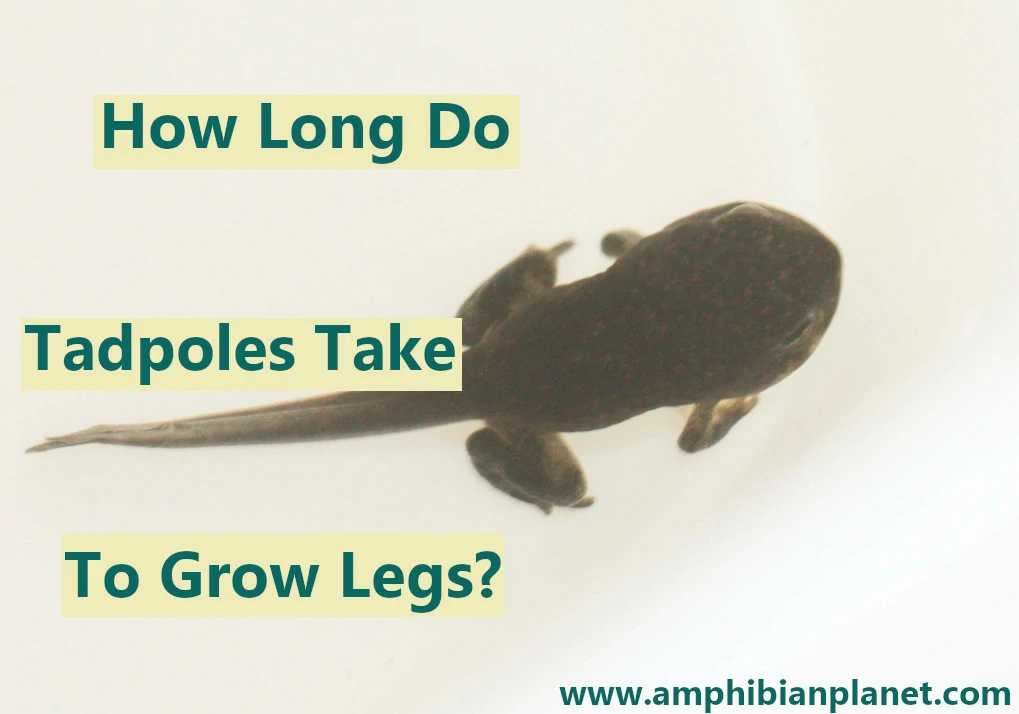Most frogs (not all), start their lives as tiny tadpoles adapted for a fully aquatic life. Tadpoles have gills on either side of their head, and a flat paddle-like tail fin to help them swim in the water. Over time, the tadpoles will grow legs, lose their tails, and metamorph into adult frogs.
On Average, tadpoles develop legs between 6 and 9 weeks after hatching. The hind legs develop first, and the forelegs shortly follow. However, tadpoles can only use their legs about 12 – 14 weeks after hatching, once they start venturing out of the water.
Once metamorphosis fully is complete, the tadpoles would have transformed into young frogs with well-developed, fully refined legs.
That said, it’s important to note that many factors can affect tadpole development rate, including the species, temperature, and availability of food.
Stages of Development: From Tadpole to a Frog
1. Hatchling Tadpole
The first few days after hatching, tadpoles won’t have the energy to swim yet. They will absorb the nutrients from the remaining egg yolk, which is in their gut.
At this stage, tadpoles have poorly developed gills, mouths, and tails, and are really fragile. They usually remain stationary and stick themselves to floating weeds or grasses in the water using little sticky organs between their mouth and belly area.
As they remain still, they develop further and become stronger, which increases their chances of survival.
2. Swimming Tadpole
After a few days, the tadpoles are strong enough to swim around and will start feeding on food sources available in the water.
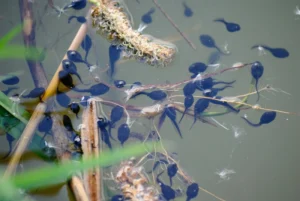
At this early stage, tadpoles have long coiled intestines that are specially designed to digest plant matter. They will only eat algae, plankton, and the soft roots of aquatic plants such as duckweed
3. Toothed Tadpole
After about 4 – 6 weeks (can vary depending on species), the tadpoles develop tiny teeth which help them grate food into tiny particles.
Their intestinal tract will also gradually shorten, and the tadpoles will start to eat animal based-foods such as insects, in addition to algae and plant matter.
Tadpoles at this stage can be fairly social creatures, and sometimes even interact and school like fish.
As the tadpoles grow, their external gills are gradually covered by skin, forming an opercular chamber with internal gills vented by spiracles.
4. Tadpole With Legs
At about 6 – 9 weeks old, the tadpoles will start to develop legs and a more refined shape to their heads. The back legs begin to appear before the front legs.
They originate as little buds from the rear of the torso, grow into paddle-like structures and then elongate into muscular, articulated limbs at the base of the tail.
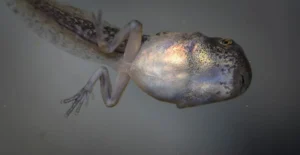
As the back legs develop, the front legs will also begin to bulge where they will eventually pop out, elbow first.
While the limbs grow, the tadpole also grows and the tail remains the primary means of locomotion. The legs come fully into action only after metamorphosis is completed.
5. Froglet Stage
At 12 – 14 weeks old, the tadpoles have well-developed legs, and their lungs are getting larger. As the skeleton continues to develop, the legs grow longer, stronger, and more refined.
Tadpoles at this stage look like tiny frogs with tails and will spend a lot of their time by the edge of the water, sometimes leaving the water.
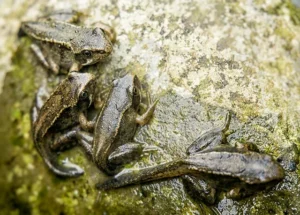
Froglets cannot survive out of water for a long time, so they will return to their pond frequently at this stage.
6. Young Frog
At about 14 – 16 weeks, the tail is gradually absorbed into the body and is eventually lost. The legs are also fully functional. Once metamorphosis fully is complete, the tadpoles are now young frogs.
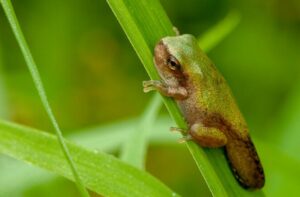
These frogs will leave the water, for life a land.
Factors That Affect Tadpole Development Rate
As earlier mentioned, there are several factors that can influence the rate at which a particular tadpole will develop.
1. Species
The tadpoles of some frog species are genetically programmed to grow and develop faster than others.
For example, frogs such as the American spadefoot toads (Scaphiopodidae), which breed in temporary pools left by rain – will typically have faster development rates, provided that the environmental conditions are supportive. This allows them to escape their ponds before the water dries up.
New Mexico spadefoot toads (Spea multiplicata), can metamorphosize from tadpole to frog in only two to three weeks.
However, frogs that breed in permanent ponds such as the American bullfrog, are in no rush to leave the water and can afford to develop at much slower rates. American bullfrog tadpoles are known to sometimes take as long as 3 years to transform into frogs.
2. Temperature
Tadpoles that hatch in early spring, when the weather is colder, usually take longer to develop – and those that hatch later when the weather is warmer will typically develop faster.
This is because temperature affects development rates.
In general, tadpoles and other amphibian larvae will develop faster in warmer temperatures and slower in colder temperatures.
Amphibians are ectothermic (cold-blooded)which means their body temperature varies with surrounding environmental temperature. As the temperature changes, so does their metabolism.
For tadpoles to develop normally and metamorph into froglets, the surrounding water temperature should stay within a certain range.
If the water temperature rises above their preferred range, developmental abnormalities occur and the tadpoles can experience high mortality rates.
On the opposite end, If the temperatures fall beyond their preferred range, the tadpoles’ metabolism and development rate will decrease – and if the temperatures drop too low, normal development ceases.
3. Food Availability
Diet is an important factor that influences tadpoles’ development, and ultimately metamorphosis.
In a lab experiment, tadpoles raised on a high-quality diet grew faster and transformed into frogs quicker than tadpoles raised on a low-quality diet.
In another experiment, tadpoles starved early in development delayed metamorphosis by 8%, and those starved midway in their development took 19% longer to undergo metamorphosis.
4. Crowding
When tadpoles are in crowded pools, they develop slower and will take longer to go through metamorphosis. Tadpoles in crowded pools have been found to develop slower even with a high availability of food.
In one experiment, a researcher raised tadpoles in different volumes of water. He found that crowding has little effect on the rate of tadpole development during the first 2 weeks. But later development was greatly affected – decreasing rapidly in crowded conditions.
It was also found that the tadpoles that grew to the greatest body size went through metamorphosis earlier than tadpoles that remained small.
In addition, another experiment found that tadpoles developed slower when raised in water previously crowded by other larger tadpoles.
5. Environmental Cues
Tadpole development rate can be influenced by various environmental cues. For instance, tadpoles in drying pools have been found to respond by metamorphosing more quickly.
However, the newly metamorphosed frogs will grow up to be smaller frogs than those that came from slower-drying pools.
Sources:
Jeffrey Abraham Goldstein (2007). The effect of temperature on development and behavior of relict leopard frog tadpoles (Rana onca). UNLV Retrospective Theses & Dissertations.
Jacobson, Brianna & Cedeño-Vázquez, José & Avalos, Julio & González-Solís, David. (2019). The effect of diet on growth and metamorphosis of Triprion petasatus (Anura: Hylidae) tadpoles. Herpetological Conservation and Biology. 14. 308-324.
Audo, M.C., Mann, T.M., Polk, T.L. et al. Food deprivation during different periods of tadpole (Hyla chrysoscelis) ontogeny affects metamorphic performance differently.Oecologia 103, 518–522 (1995). https://doi.org/10.1007/BF00328691
Light LE. Growth Inhibition in Crowded Tadpoles: Intraspecific and Interspecific Effects. Ecology. 1967 Sep;48(5):736-745. doi: 10.2307/1933731. PMID: 34493010.
Lynn, W. G., & Edelman, A. (1936). Crowding and Metamorphosis in the Tadpole. Ecology, 17(1), 104–109. https://doi.org/10.2307/1932955

